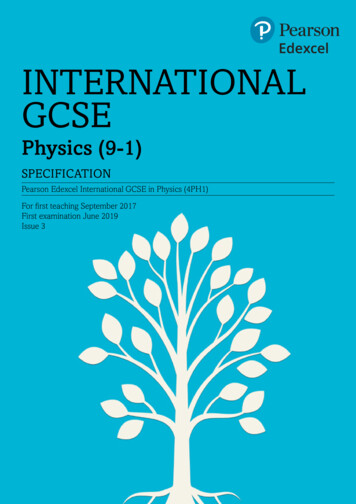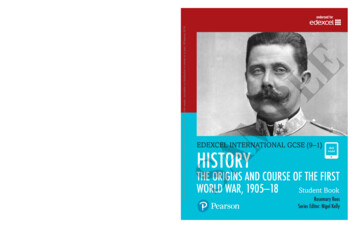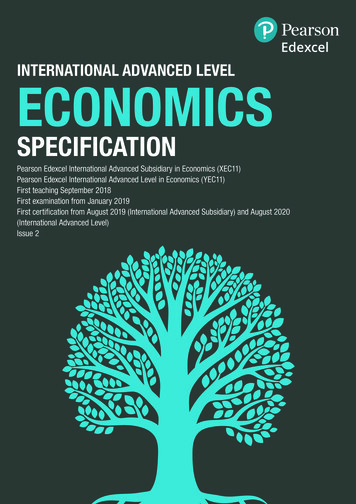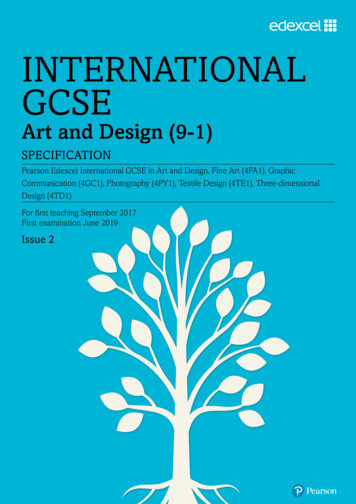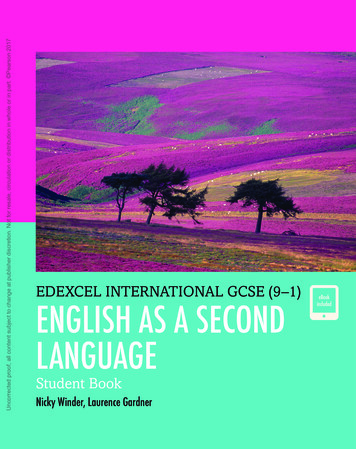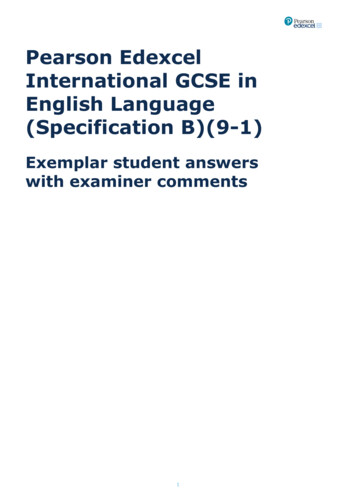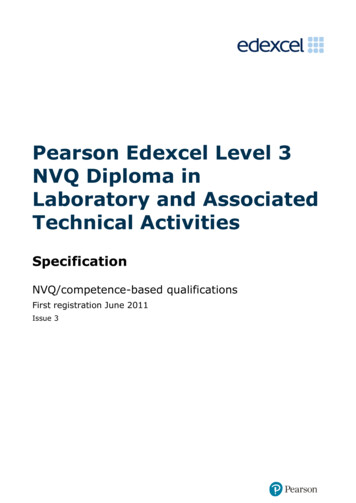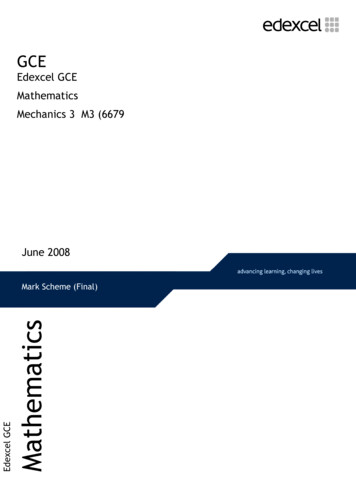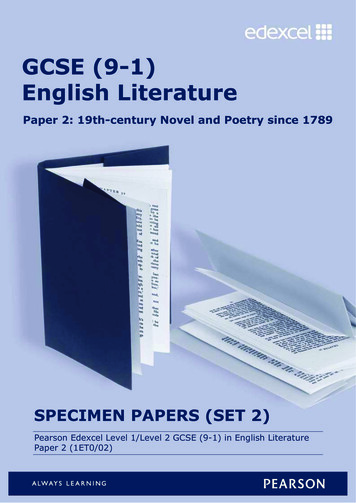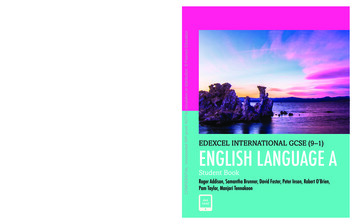
Transcription
Student BookRoger Addison, Samantha Brunner, David Foster, Peter Inson, Robert O’Brien,Pam Taylor, Manjari TennakoonPearson Edexcel International GCSE (9–1) English Language A prepares studentsfor the new 2016 International GCSE (9–1) English Language A specification. Thisbook provides comprehensive coverage of the specification and is designed tosupply students with the best preparation possible for the examination: Written by a team of highly experienced International GCSE English teachersand authorsChapters are mapped closely to the specification to provide comprehensivecoverage and are enhanced by targeted reading and writing skill sectionsLearning is embedded with differentiated exercises and exam practicethroughout, including summary sections to review learningSignposted transferable skillsMaps to the Pearson Progression ScaleReviewed by a language specialist to ensure the book is written in a clear andaccessible style for students whose first language may not be EnglishGlossary of key English Language terminologyeBook includedTeacher support materials available onlineSTUDENT BOOK ENGLISH LANGUAGE A EDEXCEL INTERNATIONAL GCSE (9 –1)ENGLISH LANGUAGE AFor Edexcel International GCSE English Language specification A (4EA1) for firstteaching 2016www.pearsonglobalschools.comCONFIDENTIAL: Uncorrected WIP proof, NOT for circulation or distribution. Pearson Education.EDEXCEL INTERNATIONAL GCSE (9 –1)EDEXCEL INTERNATIONAL GCSE (9 –1)ENGLISH LANGUAGE AStudent BookRoger Addison, Samantha Brunner, David Foster, Peter Inson, Robert O’Brien,Pam Taylor, Manjari TennakooneBookincludedCVR ENGA SB 2564 CVR.indd 124/10/2016 13:31
CONFIDENTIAL: Uncorrected WIP proof, NOT for circulation or distribution. Pearson Education.Online access to your ActiveBookThank you for buying this Edexcel International GCSE English A Student Book. It comes with three years’ access* toActiveBook – an online, digital version of your textbook. You can personalise your ActiveBook with notes, highlightsand links to your wider reading. It is perfect for supporting your coursework and revision activities.*For new purchases only. If this access code has already been revealed, it may no longer be valid. If you have bought this textbooksecond hand, the code may already have been used by the first owner of the book.How to access your ActiveBook1Scratch the panel off with a coin to reveal your unique access code. Do not use a knife or other sharp objectas it may damage the code.2Go to www.pearsonactivelearn.com3If you already have an ActiveLearn Digital Services account (ActiveTeach or ActiveLearn), log in and click‘I have a new access code’ in the top right of the screen. Type in the code above and select ‘Activate’.4If you do not have an ActiveLearn Digital Services account, click ‘Register’. It is free to do this. Type in the code above and select ‘Activate’. Simply follow the instructions on screen to register.Important information The access code can only be used once. Please activate your access code as soon as possible, as it does have a ‘use by date’. If your code has expiredwhen you enter it, please contact our ActiveLearn support site at digital.support@pearson.com The ActiveBook will be valid for three years upon activation.Getting help To check that you will be able to access an ActiveBook, go to www.pearsonactivelearn.com/supportand choose ‘Will ActiveLearn Digital Service work on my computer?’ then select ‘Run system check’. If you have any questions about accessing your ActiveBook, please contact our ActiveLearn support site atwww.pearsonactivelearn.com/supportCVR ENGA SB 2564 CVR.indd 224/10/2016 13:31
CONFIDENTIAL: Uncorrected WIP proof, NOT for circulation or distribution. Pearson Education.EDEXCEL INTERNATIONAL GCSE (9 –1)ENGLISH LANGUAGE AStudent BookRoger Addison,Samantha BrunnerDavid FosterPeter InsonRobert O’BrienPam TaylorManjari Tennakoon
Published by Pearson Education Limited, 80 Strand, London, WC2R0RL.CONFIDENTIAL: Uncorrected WIP proof, NOT for circulation or distribution. Pearson Education.www.pearsonglobalschools.comCopies of official specifications for all Pearson qualifications may befound on the website:www.qualifications.pearson.comText Pearson Education Limited 2016Edited by Lauren Bickley, Fleur Frederick and Andrew LoweTypeset by Phoenix Photosetting, Chatham, KentOriginal illustrations Pearson Education Limited 2016Cover design by Pearson Education LimitedThe rights of Roger Addison, Samantha Brunner, David Foster, PeterInson, Robert O’Brien, Pam Taylor and Manjari Tennakoon to beidentified as authors of this work have been asserted by them inaccordance with the Copyright, Designs and Patents Act 1988.First published 201619 18 17 1610 9 8 7 6 5 4 3 2 1British Library Cataloguing in Publication DataA catalogue record for this book is available from the British LibraryISBN 978 0 435 18256 4Copyright noticeAll rights reserved. No part of this publication may be reproduced inany form or by any means (including photocopying or storing it in anymedium by electronic means and whether or not transiently or incidentally to some other use of this publication) without the written permissionof the copyright owner, except in accordance with the provisions of theCopyright, Designs and Patents Act 1988 or under the terms of a licenceissued by the Copyright Licensing Agency, Saffron House, 6 –10 KirbyStreet, London EC1N 8TS (www.cla.co.uk). Applications for the copyright owner’s written permission should be addressed to the publisher.Printed inAcknowledgementsThe author and publisher would like to thank the following individualsand organisations for permission to reproduce photographs:(Key: b-bottom; c-centre; l-left; r-right; t-top)All other images Pearson Education LimitedWe are grateful to the following for permission to reproduce copyrightmaterial:Every effort has been made to contact copyright holders of materialreproduced in this book. Any omissions will be rectified in subsequentprintings if notice is given to the publishers.A note from the publisherIn order to ensure that this resource offers high-quality support forthe associated Pearson qualification, it has been through a reviewprocess by the awarding body. This process confirms that this resource fully covers the teaching and learning content of the specification or part of a specification at which it is aimed. It also confirms thatit demonstrates an appropriate balance between the development ofsubject skills, knowledge and understanding, in addition to preparation for assessment.Endorsement does not cover any guidance on assessment activitiesor processes (e.g. practice questions or advice on how to answerassessment questions), included in the resource nor does it prescribe any particular approach to the teaching or delivery of a relatedcourse.While the publishers have made every attempt to ensure that adviceon the qualification and its assessment is accurate, the official specification and associated assessment guidance materials are the onlyauthoritative source of information and should always be referred tofor definitive guidance.Pearson examiners have not contributed to any sections in this resource relevant to examination papers for which they have responsibility.Examiners will not use endorsed resources as a source of material forany assessment set by Pearson.Endorsement of a resource does not mean that the resource isrequired to achieve this Pearson qualification, nor does it mean that itis the only suitable material available to support the qualification, andany resource lists produced by the awarding body shall include thisand other appropriate resources.
CONFIDENTIAL: Uncorrected WIP proof, NOT for circulation or distribution. Pearson Education.CONTENTSiiiCOURSE STRUCTURE00PREFACE0001 READING SKILLS0002 WRITING SKILLS0003 PAPER 10004 PAPER 20005 PAPER 300EXAM PREPARATIONS00GLOSSARY00INDEX00
CONFIDENTIAL: Uncorrected WIP proof, NOT for circulation or distribution. Pearson Education.ivCOURSE STRUCTURE2READINGSKILLS24WRITINGSKILLSPAPER 1: NONFICTION ANDTRANSACTIONALWRITING564 TEXT ANALYSIS26 VOCABULARY4 SKIMMING FOR THE MAINIDEA26 CHOOSING THE RIGHTVOCABULARY6 EXPLICIT AND IMPLICITMEANING28 VOCABULARY FOR EFFECT58 NON-FICTION TEXTS30 LANGUAGE FOR DIFFERENTEFFECTS58 TYPES OF TEXT8 POINT, EVIDENCE, EXPLAIN10 EVALUATING A TEXT32 WHY OUR CHOICES MATTER78 I DENTIFYING THE WRITER’SPERSPECTIVE81 AUDIENCE AND PURPOSE16 USE OF LANGUAGE34 SENTENCES16 WORD CLASSES34 SENTENCE TYPES18 CONNOTATIONS36 OPENING SENTENCES87 F ACT, OPINION AND EXPERTADVICE20 DIFFERENT SENTENCETYPES38 SENTENCES FOR EFFECTS89 THE STRUCTURE OF A TEXT40 SENTENCE PURPOSE91 UNSEEN TEXTS22 SENTENCES FOR EFFECTS83 L ANGUAGE FOR DIFFERENTEFFECTS95 PUTTING IT INTO PRACTICE42 STRUCTURE42 PRINCIPLES OFSTRUCTURE99 TEXT ANTHOLOGY:44 PARAGRAPHING FOREFFECT99 ‘ THE DANGER OF A SINGLESTORY’ – CHIMAMANDANGOZI ADICHIE46 LINKING IDEAS48 PUNCTUATION ANDSPELLING48 ENDING A SENTENCE49 COMMAS50 APOSTROPHES51 COLONS, SEMI-COLONS,DASHES, BRACKETS,ELLIPSES52 COMMON SPELLINGERRORS53 PROOF-READING,CHECKING AND EDITING54 IMPROVE YOUR WRITINGNON-FICTION PASSAGE TO AFRICA –106 AGEORGE ALAGIAH111 T HE EXPLORER’S DAUGHTER – KARI HERBERT116 E XPLORERS, OR BOYSMESSING ABOUT – STEVENMORRIS ETWEEN A ROCK AND A120 BHARD PLACE – ARON RALSTON125 ‘ YOUNG AND DYSLEXIC?YOU’VE GOT IT GOING ON’ –BENJAMIN ZEPHANIAH GAME OF POLO WITH A131 AHEADLESS GOAT – EMMALEVINE
CONFIDENTIAL: Uncorrected WIP proof, NOT for circulation or distribution. Pearson Education.COURSE STRUCTURE136 B EYOND THE SKY ANDEARTH: A JOURNEY INTOBHUTAN – JAMIE ZEPPA IS FOR HAWK – HELEN144 HMACDONALD HINESE CINDERELLA –150 CADELINE YEN MAH155 COMPARING TEXTS155 I DENTIFYING KEYINFORMATION157 ANALYSING THE TEXTS165 COMPARISONS169 SELECTING EVIDENCE171 PUTTING IT INTO PRACTICE175 TRANSACTIONALWRITING175 A N INTRODUCTION TOTRANSACTIONAL WRITINGPAPER 2:POETRY ANDPROSE TEXTSAND IMAGINATIVE WRITING210212 READING SKILLS:FICTION TEXTS212 TYPES OF TEXT215 FIGURATIVE LANGUAGE306 NARRATION308 CHARACTERS ONOLOGUES AND310 MDIALOGUES318 P UTTING IT INTO PRACTICE– SAMPLE QUESTIONS233 TEXT ANTHOLOGY:FICTION233 ‘ DISABLED’ – WILFREDOWEN246 T HE BRIGHT LIGHTS OFSARAJEVO – TONYHARRISON206 PUTTING IT INTO PRACTICE304 STRUCTURE225 STRUCTURE185 WRITING FOR AN AUDIENCE204 IDEAS AND PLANNING303 PLOT316 SENTENCES FOR EFFECT242 ‘ AN UNKNOWN GIRL’ –MONIZA ALVI PENINGS AND CONCLU202 OSIONS301 GENERATING IDEAS223 NARRATIVE VOICE RITING FOR A PURPOSE:181 WARGUE, PERSUADE, ADVISE199 SENTENCES FOR EFFECT299 O VERVIEW OF IMAGINATIVEWRITING312 DESCRIPTIVE WRITING238 ‘OUT, OUT’ – ROBERT FROST195 VOCABULARY FOR EFFECTWRITING REATING CHARACTER,219 CATMOSPHERE ANDEMOTION RITING FOR A PURPOSE:177 WINFORM, EXPLAIN, REVIEW189 FORM299 IMAGINATIVE252 ‘ STILL I RISE’ – MAYAANGELOU260 T HE STORY OF AN HOUR –KATE CHOPIN265 T HE NECKLACE – GUY DEMAUPASSANT274 ‘ SIGNIFICANT CIGARETTES’(FROM THE ROAD HOME) –ROSE TREMAIN280 ‘ WHISTLE AND I’LL COME TOYOU’ (FROM THE WOMAN INBLACK) – SUSAN HILL288 NIGHT – ALICE MUNRO314 VOCABULARY FOR EFFECTPAPER 3:POETRY ANDPROSE TEXTSAND IMAGINATIVE WRITING320233 [TO BE CONFIRMED]322 PAPER 3 COURSEWORK SSIGNMENT A: POETRY324 AAND PROSE TEXTS SSIGNMENT B:330 AIMAGINATIVE WRITING336EXAMPREPARATIONPLANNINGYOUR ANSWERS338v
CONFIDENTIAL: Uncorrected WIP proof, NOT for circulation or distribution. Pearson Education.viINTRODUCTIONINTRODUCTION TO THE COURSEThis book has been written to help all students taking the Edexcel International GCSE English Language A (4EA1)(first examination June 2018). It is designed to enable them to achieve their full potential during the course and inthe examination. It is written for both students and teachers. There are two specifications for the International GCSEexamination, English Language A (4EA1) and English Language B (4EB1). Specification A of the International GCSEhas two routes, one assessed entirely through examination and one that includes coursework. This book will preparestudents for all aspects of the course.STUDENTSHow will this book support you? We hope you will find it: useful in terms of developing your skills and techniques fully for the Edexcel International GCSE in English Language a helpful guide to your study of the selected texts from the Edexcel Anthology for the International GCSE a support in preparing for unseen passages (all specifications).This book will also assist in writing the coursework and planning revision.STUDENTS AND TEACHERSThe book goes through the requirements for specification A, with explanations, suggestions and questions. It alsoincludes a large number of practical activities and examples. These are for practice and will also help you to appreciatehow really good answers are written and structured.HINTRemember to plan your work. The sooner you organise yourself and your ideas, the easier you will find your preparation for every section ofthe examination! This book aims to give you confidence by improving your skills and techniques. You know you can succeed.KNOW YOUR TEXTSIt is very important to make sure that you have a really good grasp of the selected fiction and non-fiction passages andpoems from Section A and Section B of the Anthology. Every year, examiners read International GCSE scripts in whichthe candidates write in a way that shows that they do not understand, or have not prepared carefully, the texts that areset. Use the relevant sections from this book to strengthen your knowledge of the texts.USE YOUR SOURCESAn important part of Paper 1 is the testing of your ability to think on your feet when confronted with unfamiliar (unseen)prose passages, to show that you have all understood and responded to these and that you can base your own writingon the ideas you have met. Work through the ‘Types of text’ chapter in order to ensure that you are ready to read andanalyse an unseen passage in Paper 1.KNOW AND APPLY PROPERLY YOUR TECHNICAL TERMSLike other subjects, English has a number of technical terms which you may need to use. It is important that you knowhow to use the correct term and that you can spell it. Refer to the subject vocabulary within the margins or the Glossaryon pages 192–197 to help you. Even more important is that you know how to explain why a particular device is used,looking at the writer’s intentions. In the exams, you will always be given credit for explaining the effects of a word orphrase, whether or not you use the technical terms, and accurate use of the right terms will make your writing morefluent and concise.HINTMake lists of technical terms, write out what you think they mean, then check your definitions against the glossary at the back or the lists ofsubject vocabulary in the margins.
CONFIDENTIAL: Uncorrected WIP proof, NOT for circulation or distribution. Pearson Education.INTRODUCTIONEXPLORE HOW TO IMPROVE THE STRUCTURE AND ORGANISATION OF YOURANSWERSIf you look closely at the model answers that are given at various points throughout this book, this will help you to writedetailed, successful responses.PRESENTING YOUR WORK EFFECTIVELYHow you set out your own writing is important for various reasons. Get into the habit of producing writing that is: neat, regular and clear correctly punctuated spelt accurately set out in clear paragraphs.Such strengths in your writing will bring many advantages, both in the examination and afterwards. Examiners will form a positive impression of your work. They will be able to read your answer easily; they will not be able to do so if your handwriting is poor or if it is notwritten in proper sentences. How you write, as well as what you write, will be considered when your work is marked. Good writing is useful for applications for jobs or college courses. Many jobs need people who can write clearly, accurately and precisely.KNOWING YOUR OWN STRENGTHS AND WEAKNESSESIt is an excellent idea to keep a checklist of your most common errors in spelling, punctuation and grammar, since theseare assessed in all specifications. When you receive a piece of work back from your teacher, read it through and makesure you understand any comments or corrections. Keep a sheet of file paper at the front or back of your work file and write the correct spelling of words you havemisspelt on it. Refer to this before handing in your work, to make sure you have not made the same mistakes. Take some time to learn the spellings and other points on your list. REMEMBER! Make the best use of lesson time.Make sure you know what you have to do in class.Be sure you understand what the homework is.For Coursework route: check what your courseworkassignments are. TAKE PART! Ask questions in class.Answer questions in class.Contribute to discussion.Be fully involved in group work. Don’t let others do all thetalking! MAKE NOTES! KEEP UP!class work; articles or worksheets. For International GCSE Specification A or the Certificate:annotate your copy of the Anthology carefully. Add points missed onto the end of your homework orpractice questions when they are returned to you.Hand work in on time.Keep files or exercise books up to date.Make sure you do not get behind with your homework.Do not leave work unfinished. It is always difficult to rememberwhat has been missed unless you amend it at the time. Check off completed work in your records Write down key points from: teachers; books you read; SEEK HELP! Ask teachers to explain if you are unsure. Discuss with friends. Look things up using dictionaries, encyclopaedias and theInternet. BE ORGANISED! Have clear systems.Present work neatly.Set yourself targets.Stick to deadlines.HINTUse a system such as different coloured cards or sticky notes to put down the key points on each text.vii
CONFIDENTIAL: Uncorrected WIP proof, NOT for circulation or distribution. Pearson Education.viiiABOUT THIS BOOKABOUT THIS BOOKThis book is written for students following the Edexcel International GCSE (9–1) English Language A specification. ThisStudent Book covers both years of the course.The course has been structured so that teaching and learning can take place in any order, both in the classroom and forindependent learning. The book contains five chapters: Reading Skills, Writing Skills, Paper 1, Paper 2 and Paper 3.The Reading Skills and Writing Skills chapters cover fundamental areas of these two key areas of English Language.They build on and reinforce what students already know and develop essential skills that will allow them to succeed atEasy to understand,core points to be takenaway from sections ortexts.Chapters and Units arecarefully tailored to address key assessmentobjectives central to thecourse.2TEXT ANALYSIS SKIMMING FOR THE MAIN IDEA OR THEMELESSON OBJECTIVESThis lesson will help you to understand the main ideasthat a writer is communicating summarise the key points of atext quickly build confidence inindependent readingTEXT ANALYSIS SKIMMING FOR THE MAIN IDEA OR THEMESKIMMING AND SCANNINGTEST YOURSELF!It can be difficult to know where to start when approaching a textfor the first time. To be confident in handling new texts, you needa methodical approach that allows you to understand the mainideas that are being communicated.Skimming and scanning are two important reading techniques.They are often confused with one another but they are verydifferent skills, though both help you to achieve the same aim: toread more quickly and effectively.KEY POINTSWhat you read is more important thanwhat you leave out. SKIMMINGSKIMMING AND SKIPPINGThis is useful when you want to get a general idea of what a text is about ina short space of time. It means looking through material quickly for a senseof the topic and the ideas and information being conveyed. When you skim,you read through an article three to four times faster than when you readeach word.WHEN SHOULD I SKIM? When reading non-fiction textsWhen you have a lot to read in a short space of timeWhen revising topics to identify key informationTo locate and identify reliable information when researching a topicTo identify what information is not relevant when researching a topicWhen you already have some background information about aparticular topic and want to find out something newSKIMMING OR SCANNING?Read the following examples and identify which describes the process ofskimming, and which describes scanning.1 You flick through a financial report to find a particular set of data.2 You quickly go through a twenty-page report in a few minutes, anddetermine the overall subject, tone, and a few key points.3 You pick up a newspaper at a coffee shop, look over the first few pages,and gather some general information about the events happening inthe world.4 You open a local newspaper, find the section advertising rooms for rent,and then mark a few advertisements in your desired location within yourprice range.SKIMMING OR SCANNING?To skim effectively, you don’t read everything – you must skip, too. So whatmaterial should you read and what should you leave out? These readingstrategies for active reading should help you:1 Highlight key points.2 Consider each paragraph by rephrasing the first point of each in yourown words.3 Underline any unfamiliar words. Can you use the context of the sentence tohelp you establish their meaning? If not, use a dictionary to help you.STRATEGIES FOR SKIMMINGRead the first sentences of each paragraph (this is called the topicsentence) – this will give you a good sense of the ideas and structure ofthe text.SCANNINGRead the first and last paragraphs.Scanning refers to reading through material to find specific information.When you scan, you run your eyes over information to pull out specificwords, phrases, or information. You may not be aware of it but you scanmany types of material in your daily life, from the television guide to thefootball results in the newspaper.Some pieces of writing have headings and subheadings. These are auseful guide to the information being communicated.WHEN SHOULD I SCAN? When looking for specific pieces of information quickly To locate a relevant quotation or section in a literature textOtatet fuga. Cate voloratio molorem cum, quivoluptam fuga. Ximolutaturio. Itat voluptae dolupit quatur alitionsedit3STRATEGIES FOR SCANNINGFor scanning to be successful, you need to be sure of your purpose, iewhat information you are looking for, before you begin.You should consider the structure of the text. Is it arranged alphabetically,by category, chronologically (in time order) or in another way?You can use your index finger to help you to identify key information, forexample, a train or bus time. Move it down the text with your eyes tomaintain focus.Te resersperum faccumqui ra aut enihitdiatquae sumet, eatin esendam quia aceptatatur? Mo ex etur?
CONFIDENTIAL: Uncorrected WIP proof, NOT for circulation or distribution. Pearson Education.ABOUT THIS BOOKixthis course. They can be taught as blocks at the start of the course or integrated into relevant sections of the texts beingstudied.The Paper 1 and Paper 2 chapters cover all of the content required by the course, mirroring the two exam papers forthose taking this route. The information in the Paper 2 chapter will also work for anybody taking the coursework route.This is then supplemented by the Paper 3 chapter, which gives advice on this paper for those taking this route.For each section or Anthology text, information is interspersed with activities in order to put learning into practice andexam-style questions to help you prepare and practise for the exam. Other features help to expand your knowledge andreinforce your learning. All Anthology texts are reproduced in full, with detailed analysis and questions for each text.Conscernum. Ad conrendace psenterusloccier nihicon tebefexnocastisque dem idemin vit iam ini fir licultum8LITERARY HERITAGEGENERAL VOCABULARYbanishment the act of sending someoneaway permanently from their country orthe area where they live, especially as anofficial punishmentENGLISH LITERATURELITERARY HERITAGETHE NURSELORD MONTAGUEThe Nurse is: like a mother in herprotective attitudes toJuliet devoted to the Capuletfamily but prepared to takerisks to help Juliet inclined to chatter a greatdeal and is the source ofmany comical exchanges prepared to go against herown views in the adviceshe gives to Juliet aboutmarrying Paris happy to tease Julietinitially by withholdinginformation from Romeo.Lord Montague is: the father of Romeo head of the Montaguefamily the person who reports hiswife’s death.BENVOLIOBenvolio is: a good friend of Romeoand his cousin a different kind of manfrom Mercutio and Tybalt –he is neutral and fair keen to stop the fightingbetween the families; apeace-maker someone who, as hisItalian name suggests(translated as ‘wishingwell’ in English), wants thebest outcome a reliable go-betweenfor the Montagues andEscalus.MERCUTIOMercutio is: the best friend of Romeo,to whom he is very loyal intelligent, quick andclever; a strong characterwith strong opinions someone who likes a jokeand likes to make fun ofpeople, including Romeo always looking for a fight,which leads to his death.Ut fugit dolupti asremodic ipsus, est offictore moditasrerescientor andam disconsectas re, totat.Lectus eossequi voluptat pra excea ipicaboreperum, officie ndanimre doluptaque mo vendantio id moluptat.ENGLISH LITERATURE9ACTIVITY 3 CONSIDERING CHARACTERYou can learn a great deal about the different characters by studying aparticular scene in detail. A good example is the central scene (Act 3,Scene 1) in which Romeo kills Tybalt.Working with a partner, in a group or by yourself, think about and makenotes on the following points. What happened in the previous scene, and therefore whatmood is set for the audience. The signs that a fight is starting. Whether the fighting and killing are presented as inevitable. Links with the fight at the start of the play. How the audience feels about Romeo at the end of the scene. How the scene sets up the characters for the next scene.(How does it relate to the preceding and following scenes?) How the end of the scene relates to the earlier fight and thewarning from the Prince in Act 1.LADY MONTAGUELady Montague is: the mother of Romeo so full of grief afterRomeo’s banishment that shedies.TYBALTTybalt is: the cousin of Juliet a very aggressivecharacter interested in picking fightswith the Montagues full of hatred and anger.THEMESLOVEAO1GENERAL VOCABULARYsuperficiality the quality of appearing tobe true or real, but only on the surfaceFRIAR LAURENCEThe Friar is: a religious figure who actsout of concern for Romeo able to offer Romeo advicebecause he knows himvery well someone who seems wiseand knowledgeable and istrusted brave, as he is prepared tosuggest a very risky planthat does not work outwell; he could be blamedby some for the deaths ofRomeo and Juliet a schemer, who has a planto end the feud betweenthe families, based on theplan he offers Juliet.Many plays, including those of Shakespeare, look at different types of love.We are introduced to Romeo as someone whose feelings for Rosaline mightbe called infatuation; he is immediately shown as completely love-struck,but the superficiality of his feelings is underlined by the speed with which heabandons them at the sight of Juliet.The play gives several examples of close friendship as a form of love,particularly the protective love shown by the Nurse to Juliet and the Friar toRomeo; as well as the ‘laddish’ friendships of the young men, which are stillinstantly recognisable in any street in Italy today, and marked by what theItalians themselves call braggadocio (a kind of boastful swagger). However,such friendship can generate fierce loyalty, to the point of being willing to diefor one’s friend, as happens with Mercutio.MARRIAGEThere is also the view in 17th–century society that marriage is above all abusiness contract, in which love is not a very important consideration: Pariswishes to marry Juliet, but admits that he has ‘little talked of love’, and evenJuliet, when asked how she feels about the idea of marriage to Paris, only says‘I’ll look to like’, showing that she has little emotional investment in the idea,but will simply try the idea.SUBJECT VOCABULARYwitticism a clever amusing remarkGENERAL VOCABULARYjesting saying things that you do not reallymean in order to amuse peopleSEX AND SEXUAL REFERENCESPart of the overall treatment of love is that of sexual love. Although, clearly, themarriage of Romeo and Juliet is happily consummated, many of the referencesto sex are not directly linked to their love. Instead they are there to providean endless source of complicated puns and witticisms, particularly for theyoung men and in some instances for the Nurse. Such jesting treats love in analtogether more basic way than the idealism of the central relationship.englishlit sample2.indd 8-9Od et, conse pro quasita derumquia di doluptatiorem am, exerum etfugiate coreium fugiaecuptaspero estet,A wide range of variedactivities to encourageunderstanding andembed understandingas an individual, as wellas in larger groups toestablish cross-peerlearning and communication.08/03/2016 13:26Useful words and phrases are colour codedwithin the main text andpicked out in the marginwith concise and simpledefinitions. These willsupport understandingof key subject termsand support studentswhose first language isnot English.Otatet fuga. Cate voloratio molorem cum, quivoluptam fuga. Ximolutaturio. Itat voluptae dolupit quatur alitionseditCum escilibus enimusam qui ut volorum,et odipien turehenisveris magnis vel es sinisrest, et, omnimus, ea
CONFIDENTIAL: Uncorrec
ENGLISH LANGUAGE A STUDENT BOOK Pearson Edexcel International GCSE (9–1) English Language A prepares students for the new 2016 International GCSE (9–1) English Language A specification. This book provides comprehensive coverage of the specification and is designed to supply student
